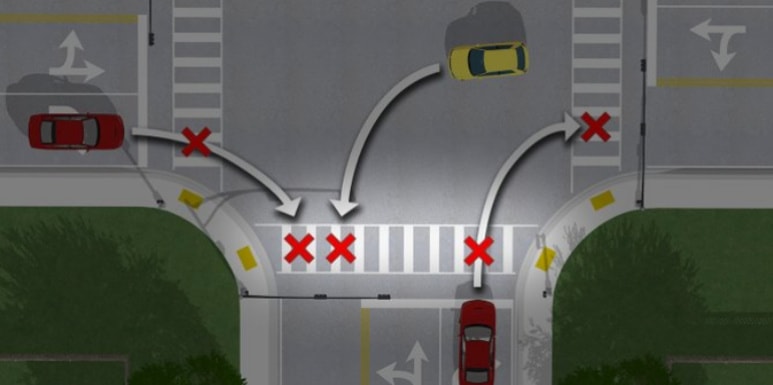Dear Premier Rankin, Mayor Savage and Member of Parliament Fillmore, Parliamentary Secretary to the Minister of Infrastructure and Communities.
I am writing to request leadership initiate a meeting with the aim of working together to address an unacceptable lack of safety for pedestrians in Nova Scotia.
Very unfortunately this is an issue where the ball has been dropped. There is not an acceptable basic standard of protection for people of all ages and abilities who rely on appropriately safe infrastructure that considers and meets their unique needs and vulnerability to impact from vehicular traffic.
As the budgets for the Province and also for the Municipality move through the decision making process, fundamental forms of mobility are not prioritised and the focus is on new infrastructure projects, many of which particularly at Provincial level relate to moving vehicular traffic faster or providing parking infrastructure for private car use.
Please let me provide you with one example of a major infrastructure oversight that has caused two fatalities and one serious life threatening injury in Halifax within the past twelve months, including the tragic and untimely recent death of Doctor Gass.
This dangerous sequence of conflict points between pedestrians and turning drivers, illustrated below with the X’s in this image from the University of Miami’s WalkSafe program, is what we have tasked pedestrians when they cross at our signalized intersections.
The exercise shown of avoiding multiple conflicts with traffic moving left and right on green lights (also right on red) over the crosswalk while pedestrians cross legally is not possible for any able and fit adult to negotiate safely, let alone our seniors, children and people with disabilities.
Neither has any recent research concluded that it is a realistic and achievable task for pedestrians, nor that drivers when turning actually do consistently yield to pedestrians. Especially on wider crosswalks, we are not seen.

Senior after senior after senior, now eleven in a row, are being killed on urban crosswalks and roads that neglect to appropriately consider the needs of people who are slower movers and cannot ascertain nor avoid the level of conflict and danger that we require them to deal with on crosswalks over multiple lane intersections and roads.
Crosswalks that lack appropriate infrastructure for the class of road, such as the one where Sarah Richardson was recently hit on Herring Cove Road, consequently losing her unborn twins, are a serious daily concern for those who rely on getting across the road safely.
I have communicated for several years in my personal time with local pedestrians who are concerned about safety; sharing information on how to raise safety concerns with staff and councillors and almost always hearing back that nothing can be done. I and others have attended leadership meetings to flag major safety omissions, such as the lack of essential advance-yield infrastructure at multiple-lane crosswalks.
Considering necessary safety adaptations for dangerous crosswalks in particular is an issue that is constantly pushed around, delayed and not dealt with adequately with sufficient understanding, strategy, funding and policy to adapt crosswalks.
Councillors seem unable to effect real change in approach and priorities, though some leadership have clearly identified what is needed including the need to reduce the width of crosswalks and implement staged crossings using refuge islands.
Some of the reasoning I hear behind not acting is very worrying – including psychological theories that drivers may get aggressive and not obey laws if congestion increases due to improvements in pedestrian safety, or that pedestrians may develop a false sense of security if their safety is improved.
Research tells us that if vehicular traffic flow is prioritised over pedestrian safety in urban areas, we get more cars and less people walking and using transit to meet their mobility needs.
As some cities and countries move to dramatically reduce car use, they of course need to achieve those targets with robust safety for people traveling by alternative modes, all of which require the safe separation of vehicle movements from vulnerable road user movements.
In the UK where I am from, directional traffic lights are used to effect separation of pedestrian movements from vehicular movements in suburban areas. In urban areas, an all-red traffic light phase is most commonly used to enable vulnerable road users to get across intersections without danger from moving traffic.
Very basic changes, like legalising directional traffic lights that turn red (not just green and amber) can provide essential protection for pedestrians crossing legally from drivers turning left – responsible recently in HRM for one serious life threatening injury and a fatality. Adequate infrastructure protection for vulnerable road users can happen, and is often found in countries with less road space yet more car users.
A decision-making ethos that prioritises vehicle movement over safety required by vulnerable road users will continue to result in serious incidents each week and the suppression of all forms of transport other than the car. This, not improvements to pedestrian safety, will worsen congestion by inducing demand for more car use.
Clear guidance and campaigns are being produced by the United Nations and the World Health Organisation regarding the need for 30 km/h speeds in all locations where vulnerable road users and vehicular traffic mix and to separate pedestrian and vehicle movements at signalized intersections.
Nova Scotia has much catching up to do on vulnerable road user safety and must change its approach to ensure everyone can travel safely, particularly if they are vulnerable road users. It is in control of change: Guidance from the Transportation Association of Canada is not binding rules, and adaptation to local conditions is encouraged.
I am asking you to initiate urgent action to meet and discuss this mobility crisis in particular for senior citizens, and to work towards appropriate strategy and funding to address it, including the following:
- Initiate a provincial road safety strategy, as proposed in 2015 by Child Safety Link. This should consider all types of mobility and what is needed in terms of policy, action and funding to support their safe movement.
- In conjunction with stakeholders and the community; develop policy and strategy that identifies the key safety issues for vulnerable road users, how they will be addressed, over what time period and with what funding.
- Develop specific provincial and municipal policy and or guidance that addresses key issues for non-car users including;
- how the requirement for a crosswalk is assessed,
- the required traffic light types and timings that do not result in dangerous conflicting movements between pedestrians and vehicles (also cyclists),
- appropriate crosswalk infrastructure
- Identify through policy or guidance the adaptations that are urgently required to higher-speed multiple lane crosswalks to support their safe use:
- For signalized intersections – traffic lights that prevent conflict
- For mid-block crosswalks on higher speed and multiple lane roads – pedestrian refuge islands, advance yield signage and infrastructure, and measures that slow approaching drivers down to safer speeds of 30 km/h such as pinch-points.
- For all other crosswalks – adaptations that ensure drivers and pedestrians can see each other and slow approaching drivers, such as pinch-points and refuge islands.
- Recognise that any form of mobility other than cars is healthier and cheaper, can substantially reduce car use in cities, requires less land use, improves the liveability and commercial potential of communities, and so should be provided with the highest priority for funding, policy and change.
- Review decisions made against the provincial sustainable transport strategy and consider how to better ensure that future infrastructure decisions meet the requirements set out in this strategy – for example investing in a Park & Ride service and bus lanes instead of providing car parking for 90% of visitors to the downtown Halifax Infirmary hospital, which may require consequent changes to urban road infrastructure to accommodate the movement of cars.
I would be very happy to assist, collaborate and advise further.
With best wishes
Martyn Williams
If you walk, cycle or use a wheelchair and are affected by road safety issues, please join HRM Safe Streets for Everyone. If your local crosswalk needs a crosswalk flag, please contact the Crosswalk Safety Society. Please remember to report issues affecting your safety to our municipal authorities using the 311 service.
See also: There’s a mobility crisis for vulnerable road users, and Halifax must change its approach
Check out our new community calendar!
With a special thanks to our generous donors who make publication of the Nova Scotia Advocate possible.
Subscribe to the Nova Scotia Advocate weekly digest and never miss an article again. It’s free!



